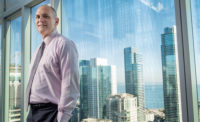“Baker is a visionary,” says Patty Walters, EERE’s legal counsel in Golden. “He not only sees the big picture, he has the skill set to make the big picture happen, which is tough in a bureaucracy,” she adds.
In 1995, when Baker’s quest for sustainable design began, the public was not focused on the subject the way it is today. He found himself facing a no-win situation as he tried to get funding for the project.
That has changed. In 2009, President Barack Obama issued an executive order that established greenhouse-gas-emission reductions for all federal agencies. Obama wants to spur energy savings in the private sector, as well; to do this, he recently proposed federal incentives for commercial energy retrofits, which he thinks can reduce annual energy costs by $40 billion.
For GSA’s 9,624 buildings, which enclose 370.2 million sq ft, U.S. General Services Administration head Martha Johnson has set an ambitious goal: She wants them upgraded to net-zero energy use.
Susan Damour, GSA’s administrator in the Rocky Mountain region, plans to meet that goal with help from Baker. “What Jeff and the RSF team offer us is the chance to mimic good behavior,” says Damour.
Later this year, the team that produced the facility—including the local design-build contractor Haselden Construction, the local architect RNL Design and the San Francisco-based sustainability consultant, Stantec—expect to celebrate the building’s designation as LEED Platinum. The ranking from the U.S. Green Building Council’s Leadership in Energy and Environmental Design green-building rating system is equivalent to an Olympic gold medal.
The lab, operated by the Alliance for Sustainable Energy LLC, is still fine-tuning the facility’s systems (see p. 49). It also is applying RSF lessons learned to a 138,000-sq-ft expansion, designed to be 17% more energy efficient than the original and cost $13 less per sq ft. The addition and a parking garage are on course to open next year. The lab also is using the RSF model for its 175,000-sq-ft Energy Systems Integration Facility, where researchers will study the integration of renewable energy technologies into the electrical grid.
Nearly 2,000 visitors have toured the RSF, among them representatives of GSA, the U.S. Army Corps of Engineers and the U.S. Dept. of Homeland Security. The lab welcomes visitors as part of its goal to spread the gospel about the new model.
Toward that end, Baker and the RSF team are talking to government builders, such as DOE’s program managers. The lab staff is talking to its constituents, including standards writers and academics. The building team is also spreading the word to the private sector. A presentation at the American Institute of Architects’ national convention, on May 12-14, is one of many scheduled.
Cost per sq ft of Research Support Facility
$335
Average cost per sq ft of 31 LEED buildings
Baker shows intolerance for waste by quietly turning off lights. His protégé, project officer Gregory D. Collette, has even found him in the office before dawn, working only by the glow of his computer screen.
Baker does not remember a pivotal moment when he became an energy Scrooge but does recall a high school teacher who opened his eyes to biology. Further, in college, he read Rachel Carson’s “Silent Spring.” Eventually, he came to believe that energy drives everything: national security, environmental health and economic competitiveness.
His humble roots may account for his frugal ways. Born in 1956, Baker grew up in a working-class family in Oak Lawn, south of Chicago. Six kids shared one bathroom in a 1,100-sq-ft house. “There was never a lot of money,” says Baker, who is the eldest.















Post a comment to this article
Report Abusive Comment